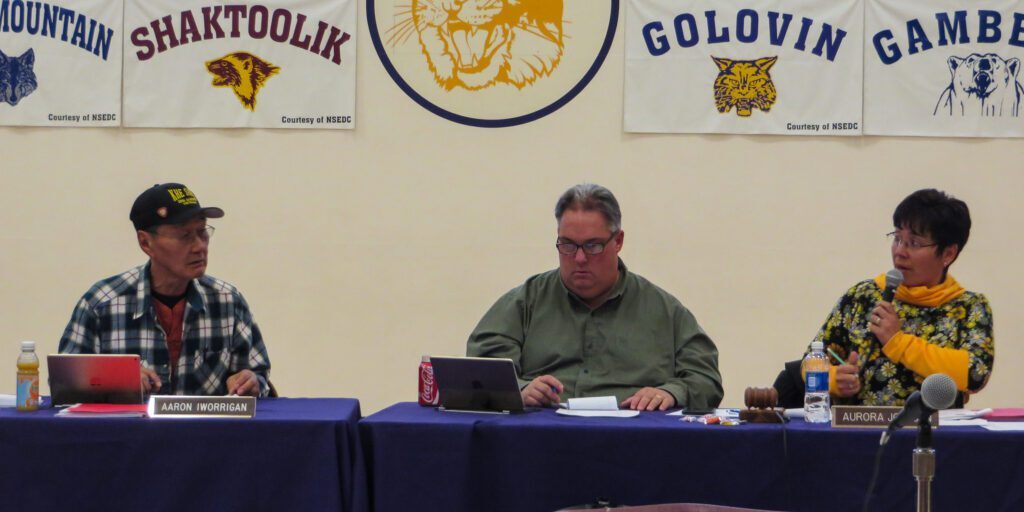The head of the Bering Strait School District has provided some clarity on how this upcoming school year will go for students and staff in the region. However, there are still some key details to be worked out, like how many days a week students will actually be in BSSD schools.
Both the Superintendent of BSSD, Dr. Bobby Bolen, and the Superintendent of Nome Public Schools, Jamie Burgess, participated in a teleconference last week hosted by Norton Sound Health Corporation. (Click the link below to hear the full audio recording of that teleconference, from 07.23.2020:)
Even though their back to school plan isn’t finalized yet, Bolen gave listeners an idea of how BSSD would account for students’ safety during the coronavirus pandemic.
“Again, the three-level plan, which is probably similar to what Mrs. Burgess’s is in Nome, however it’s based on the medium, low, and high risk. We’re still working on a formula for that. I have a spreadsheet based on some numbers of positive tests in a village or not in a village, and how many [people] have been tested to find out what we will identify as a low, medium, or high mitigation [communities].”
The three-tiered plan Bolen described is modeled after the Alaska Department of Education and Early Development’s plan that involves low, medium, and high-risk levels which are color coded as green, yellow, and red. Each color is based on the individual community’s rate of transmission of COVID-19. Burgess and NPS are following those guidelines as well.
As of last week, what kind of modified class and online schedule BSSD will use this fall is still to be determined.
Similar to Nome schools, BSSD will require all of its students and staff to get a daily temperature reading upon entering a school building, wear a mask and or a face shield while inside the classroom; although teachers with younger students will wear a face shield so the students can see their mouths move during language instruction, and take extra precautions when necessary.
“We have Plexiglass shields that are being cut as we speak, those will be on individual desks as needed, as well as in the MPR where we feed kids…There will be Plexiglass separating students from each other in any type of group setting.”
Bolen says the school district is still figuring out if they will be able to mandate school wide COVID-19 testing in the fall, which depends on if the state enforces new health mandates or not.
Holly Nayokpuk, with the Native Village of Shishmaref asked about enforcement and consequences for students who choose not to wear masks.
“Nayokpuk: What’s going to happen if the children refuse to wear a mask?
Bolen: Good question. We are still working through that because right now there is no mandate, so they (the child) may have to work with distance delivery and that would be the same if a teacher refuses to wear one [a mask]. There’s a lot of legal requirements for that and the state is actually still working through mandates and things.”
It is unclear what COVID-19 measures school districts will be able to enforce this year. But, Bolen would go on to say that if the student is deemed a danger to the health and safety of others then BSSD has the ability to educate them from a distance using various virtual methods.
The main difference between Nome’s current plan for the school year and BSSD’s, is that BSSD is accommodating dozens of new teachers coming up from the Lower 48. According to BSSD staff, the school district had a total of 53 staff vacancies going into this school year and so far, 44 of those have been filled.
Bolen explains that the school district is having their new and returning staff follow the individual community’s local quarantine requirements.
“We have new teachers that will be arriving in Anchorage beginning August 9th as well as any administrators that have left the village or traveled to the Lower 48. We’ll be testing [them] through the airport and through testing centers down in Anchorage while we quarantine.”
For example, a teacher in Shishmaref told KNOM that the local tribe and city government is having returning teachers take a COVID-19 test, then quarantine for seven days within their homes and take a second test afterwards. While Bolen says the community of Diomede is having their school staff quarantine for 14 days prior to arriving on the island.
BSSD’s policy requires all teachers currently in Alaska, or if they’ve been in Alaska for a minimum of two weeks prior, to return to the communities where they’ll be working by August 17th.
For new teachers coming to the region from outside of Alaska, Bolen says the plan is for them to fly to their home communities around the 14th or 15th and then complete their local quarantine requirements in the Bering Strait region.
Image at top: The Bering Strait School District’s board of education from 2015 — including Aaron Iworrigan, Superintendent Dr. Bobby Bolen, and Board Chair at the time, Aurora Johnson. Photo: Laura Kraegel, KNOM (2015).




